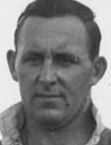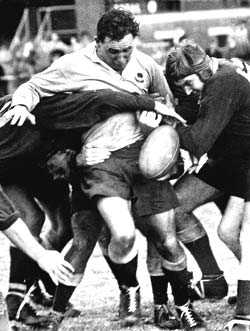Colin Windon
 | |||
| Full name | Colin James Windon | ||
|---|---|---|---|
| Date of birth | 8 November 1921 | ||
| Place of birth | Randwick, New South Wales | ||
| Date of death | 3 November 2003 | ||
| School | Sydney Grammar School | ||
| Notable relative(s) | Stan (father), Maude (mother) Keith Windon (brother) | ||
| Rugby union career | |||
| Playing career | |||
| Position | Flanker | ||
| Professional / senior clubs | |||
| Years | Club / team | Caps | (points) |
| Randwick DRUFC | |||
| Provincial/State sides | |||
| Years | Club / team | Caps | (points) |
| 1946–1953 | New South Wales | ||
| National team(s) | |||
| Years | Club / team | Caps | (points) |
| 1946–1953 | Australia | 20 | (33) |
| Coaching career | |||
| Years | Club / team | ||
| 1954–1957 | Randwick DRUFC | ||
| Rugby union career | |||
Colin Windon (8 November 1921 – 3 December 2003) was an Australian soldier and a state and national representative rugby union player who captained the Wallabies in six Test matches in 1951. He is recognised as one of Australia's greatest players of the twentieth century and is an inductee to the Australian Rugby Union Hall of Fame.[1]
Early life and sporting family
Windon attended Randwick Public School before Sydney Grammar where was a mediocre rugby player in the lower grades. He showed promise as a young cricketer and from Grammar was selected in a Combined Schoolboys representative side.
Colin's father Stan was a foundation member of the Coogee Surf Life Saving Club and played rugby with the Randwick club in Sydney. He passed his love of the game onto his sons and the elder Keith, played as a flanker for Australia in a war interrupted career between 1936 and 1946. Keith was a rare student of the game, a quality player whose best years were lost to the war. He was a star during the 1937 Springboks tour of Australia. After captain Cyril Towers had to leave the field, Keith moved to the centres and masterminded one of the great comebacks in Wallaby history. Keith was on the ill-fated 1939 Wallaby tour to England. The team docked at Southampton on the day war was declared and they returned to Australia without playing an international game. Keith Windon did manage to briefly resume his career after the war, touring to New Zealand with the 1946 Wallabies where his career ended. Seeing Keith play for Australia in 1937 at the Sydney Cricket Ground inspired Colin to pursue his own rugby career.
Like his father, Col was active at Coogee Surf Club, in the Coogee Amateur Swim Club and the Coogee Penguins Winter Swim Club. He was a national title winner at beach flags.
Club rugby and playing style
He joined Randwick in 1938 in fourth grade. The next year aged 18, he was playing first grade with the "Galloping Greens" and in that debut year he was equal-top scorer in the Sydney competition. Windon went on to play 98 first grade matches with the club.
He was a rugged, hard-tackling breakaway and a speedy, elusive runner with a notorious fend and a resultant gift for scoring tries. Howell (his teammate on the 1947–48 Wallaby tour) wrote that Windon always said his best coach was his brother Keith who schooled him in breakaway play. One of his dictums was always to look up while packing down in the scrums – to analyse the position of the opposition backs and to always run to the next line out and rest then.[2]
War service
Enlisting in the Second Australian Imperial Force on 18 December 1941 after basic training in Dubbo, Windon was posted to the 2/3 Infantry Battalion, 6th Division,[3] and saw service in the Owen Stanley Ranges in Papua New Guinea. He contracted malaria there and after convalescence in the Atherton Tablelands he returned to New Guinea in 1944 for hard jungle encounters in the Aitape-Wewak campaign during 1945. Windon was a company runner, the time-honoured military role of running messages from the front line to a command post, in his case under Japanese fire. He was discharged from the Army on 13 August 1946.[3]
Representative rugby career

Col Windon debuted for Australia on the first post-war Wallaby tour of New Zealand in 1946 captained by Bill McLean where his star began to rise. On that tour he played nine of the twelve games including both Tests. He scored two birlliant tries against the strong Wellington side.
He played twice for the New South Wales Waratahs against the touring All Blacks in 1947 and was selected in the Australian side that met them – a veritable selection trial for the nine-month Wallaby tour of Europe and North America planned for later that year.
He was one of the first selected for the 1947-48 Australian rugby union tour of Europe and North America and played in twenty seven of the tour's thirty-six matches and scoring eight tries to be the third highest tour try scorer behind three-quarters Terry MacBride, Charlie Eastes and Trevor Allan. He played in all five Tests of the tour and debuted as Australian captain in tour matches against Aberdeen and Leicester. He played eleven successive games at one stage of the tour. In the Test against England at Twickenham he dominated the match and scored two tries including the game winner late in the second half when his punishing tackle on English pivot Tommy Kemp saw Kemp spill the ball and Windon outpace the English backline defence 50m to the try line breaking England's spirit and sealing the victory.
Following the success of the marathon tour he played three Tests against the visiting NZ Maori side in 1949 and also turned out for New South Wales against them. Then in 1949 he was selected as vice-captain to Trevor Allan for another tour of New Zealand when Australia were victorious in winning the Bledisloe Cup in a two Test series – the first time that feat was achieved away from home. Windon played in ten of the twelve tour matches, scoring eight tries including a try in each Test and captaining is country in a minor game against Manawatu-Horowhenua.[4]
In 1952 he was selected for the domestic series against Fiji and that year made his third tour of New Zealand playing in nine of ten games including both Tests. His final representative tour was made to South Africa in 1953 although injury saw him make only six tour appearances.
Early in his retirement he coached at Randwick in a stint from 1954 to 1957.
Records and accolades
In 1946 he was selected by the prestigious New Zealand Rugby Almanac as one of the world's top five players. The magazine Sporting Life picked him in its All Australian team in five years 1947, 1948, 1949, 1951 and 1952.[5] For over thirty years Windon was Australia's leading Test try-scorer (11) until his record was overtaken by Brendan Moon in the 1980s. He holds the standing Australian record for the most career tries scored by a breakaway.
In 1999, he was named in Australian Rugby's team of the century. In 2000, he was made a life member of the Sydney Cricket Ground and a plaque there in the Walk of Honour commemorates his career. He was elected to Randwick City Council's Sporting Hall of Fame and awarded an Australian Sports Medal for his achievements. He consistently features in top rugby player lists as the best breakaway in Australia's rugby history. In 2005 he was honoured as one of the inaugural five inductees into the Australian Rugby Union Hall of Fame. Upon his induction Australian Rugby Union President Paul McLean referred to Windon as : "an electrifying talent and a try scoring machine".[1]
His 1947 Wallaby tour teammate Sir Nicholas Shehadie described him as follows: As back-row forwards go, he was the very best. A try-scoring machine, a superb attacker and with the speed of a three-quarter, the man they nicknamed 'Breeze' was simply peerless in supporting play.[6]
Footnotes
- ↑ 1.0 1.1 "Windon, Colin ARU Hall of Fame". aru.rugby.com.au. Retrieved 18 July 2011.
- ↑ Howell, Wallaby Captains p135
- ↑ 3.0 3.1 "WW2 Nominal Roll: Windon, Colin James". Commonwealth of Australia. Retrieved 10 May 2010.
- ↑ Howell, Wallaby Captains p138
- ↑ Howell p135& p138
- ↑ Shehadie, A Life Worth living p237
Sources
- The Spirit of Rugby (1995) (Collection of Essays) HarperCollins, Australia – (Essay specific to this article Phil Tressider's The Class of '47–48 1st published Sydney's Daily Telegraph 1987)
- Howell, Max (2005) Born to Lead – Wallaby Test Captains, Celebrity Books, Auckland NZ
- Shehadie, Nicholas (2003) A Life Worth Living, Simon & Schuster Australia
| |||||||||||||||||||||||||||||